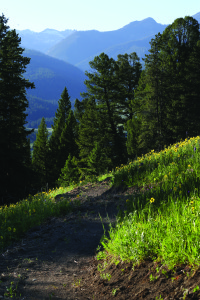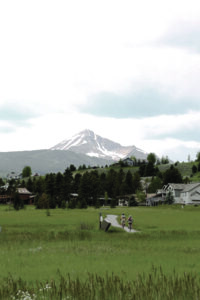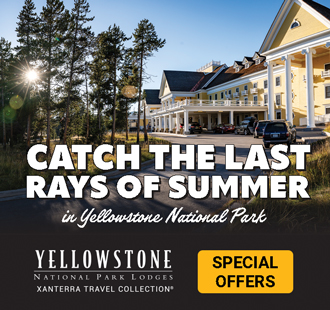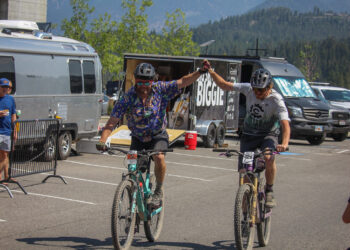By Maria Wyllie
Opie Jahn grew up in rural Cheboygan, Michigan. One of his earliest memories is walking through the woods on the meandering trail that connected his home with his grandparents’ summerhouse a quarter-mile away.
“To this day I can walk through that trail in my memory,” Jahn says. “I know all the little roots, all the little bumps. I know what the creek smells like.”
For Jahn, it was an early, subconscious connection with the environment along this trail that led him to move west and be closer to nature on a daily basis. Now an avid mountain biker, Jahn, 38, is a proponent of the growing trails system in Big Sky, Montana, where he’s called home for eight years.
Having previously lived in the area from 1999-2005, Jahn was surprised to see how little the trails system had grown when he returned in 2013. In just the past year, however, roughly 10 miles were added to the Big Sky trails network, through the help of local developers, Boyne Resorts, and the Big Sky Community Corporation. And that number is only growing.
“We’re coming into a period of time where trails are becoming very cool and public,” says Jessie Wiese, executive director of BSCC, a nonprofit working to improve and expand local parks and trails.
“That’s a shift for our community to … see trails as a valuable asset,” she said, adding that in the 1990s the Big Sky Trails Committee worked to prevent trail closures due to increasing development, as well as to create a cohesive plan for building an interconnected trail system throughout Big Sky.
BSCC’s latest endeavor is called the Community Center Trails project. The Simkins family, which is responsible for much of Big Sky’s Town Center development, awarded BSCC with eight miles of centrally located trails easements in June of 2013, which will help link neighborhoods and business centers.

BSCC finished Phase 1 of the project’s four phases in August 2014 with the completion of the Hummocks and Uplands trails, an endeavor that added five miles of moderate terrain for hikers and bikers. Planning continues this summer for Phase 2, which is a 2.2-mile trail that will link Hummocks and Uplands to Ousel Falls Trail and allow users to seamlessly connect to the Gallatin National Forest trails extending south.
Investing in an interconnected trails system is a no-brainer for developers like Bayard Dominick, Vice President of Planning and Development for Lone Mountain Land Company, which is collaborating with Boyne and BSCC to construct more than 30 miles of new trails by the end of 2015.
“We see trails as being one of the most important summer amenities we can develop, both for tourists and the community,” Dominick said.
LMLC is the development arm of CrossHarbor Capital Partners – the Boston, Massachusetts-based investment firm that owns Spanish Peaks Mountain Club and Moonlight Basin, and has majority interest in the group that owns the Yellowstone Club.
The partners are working to create a “village-to-village” trail experience, linking the Big Sky Mountain Village, the Meadow Village and Town Center, Spanish Peaks Mountain Club, and the Moonlight and Madison lodges.
“It’s a really important part of community building – connecting all the neighborhoods,” Dominick said. “We will continue to build trails as we move forward with development.”
Big Sky’s summer market is smaller compared to winter, meaning it’s one of the most important markets for growth, according to Dominick. Having an interconnected trails system, he says, is a cost-effective way to enhance the summer experience.
While expert, downhill mountain biking trails are prevalent in Big Sky, the new multi-use trails will encourage greater inclusivity. “We’re trying to make it so there’s a trails network for all levels of bikers and hikers,” Dominick said. “You don’t have to be an expert to enjoy them.”
Dominick envisions a European experience, connecting trail users across mountain peaks where they can stop and enjoy on-mountain dining, view wildlife, and never step foot in a car.
Trails by the numbers
Now more than ever, trails are becoming vital parts of community infrastructure nationwide.
Headwaters Economics, a nonprofit research group based in Bozeman, Montana, works to improve community development and guide land-management decisions in the West. Recently, the group compiled more than 90 studies on the impacts of trails, with the goal of helping community leaders, elected officials and trail users better understand the benefits of trails.
“We got interested in this because there isn’t one single super-study that answers all the questions,” said Chris Mehl, Bozeman City Commissioner and Policy Director at Headwaters.
Four main themes emerged from the studies:
(1) Trails can generate business impacts and create new jobs
(2) Trails are a valuable part of residents’ quality of life
(3) Homes near community trails often have higher property values
(4) Trails are associated with increased physical activity and improved public health
Mehl says trails serve as tools, helping towns compete for economic development. “The communities that have [trails] have a competitive advantage compared with communities that don’t,” he said.
Wyoming is seeing similar impacts. A Jackson Hole Pathways and Trails survey released in May analyzed Teton County residents’ uses and opinions of local pathways and trails. Headwaters Economics along with Boulder, Colorado-based market research firm RRC Associates directed the first-of-its-kind survey.
When asked the top two reasons why people move to or stay in Teton County, 96 percent of participants said outdoor recreation, and 91 percent said access to public lands.
“Trails are the key to both of these things,” said Lauren Dickey, Education Director for Friends of Pathways, the community’s advocate for a complete pathways system. Dickey shared another stat: 90 percent of those surveyed said they use trails an average of 13.6 days per month – approximately every other day in summer and one in three days during winter.
“That’s incredible,” she said. “It’s the access we have – trails are a core to life here. Maybe you don’t move here because of the access to trails, but now that we’re here we couldn’t live without it.”
For Opie Jahn, increased accessibility means he rides his bike more because he can. “I go out to my garage, put my gear on, ride across the field, and I’m on singletrack,” said Jahn, who lives in Big Sky’s Southfork subdivision. “I can link everything together.”
From a quality of life perspective, connectivity and accessibility are significant in the face of community growth. Bozeman is currently home to approximately 40,000 people and Mehl anticipates it will reach 150,000 by 2065.
Realizing this substantial population growth requires planning ahead, Bozeman residents voted in favor of a Complete Streets policy in 2010, as well as a $15 million bond in 2012 to build trails and buy parklands.
“Property prices are going up, and if we don’t do it now … it either won’t be possible to put in a large community park, or we’ll have trails to nowhere that dead end on both sides,” Mehl said. “The days when you go to the trailhead and expect that you’ll be the only car there – those days are over.”
Even so, he says, we need not despair. “We aren’t the first ones to do this, but we have to plan for it.”
Big Sky, too, has experienced the struggle of adding trails after subdivisions have already been platted, resulting in missed opportunities for connectivity, according to BSCC’s Wiese, whose organization now must negotiate with landowners over trail easements. “Connectivity is harder than it would have been because it’s now all subdivided,” she says.
Even though developers are required to set aside open-space parcels, they’re often placed in undevelopable spots. This makes building trails difficult, says Pete Costain, who owns Whitefish-based Terraflow Trail Systems and is leading the construction of this summer’s trail-connecting projects in Big Sky.
“Although substantial designated open space exists within Spanish Peaks, the corridors that exist often did not provide the ideal alignment for functional trail layout,” Costain said, referring to the network of Spanish Peaks Mountain Resort trails he built in Big Sky last summer. “Many of the open-space corridors follow drainages or marshy areas, which led to complex route-finding scenarios.”
Dominick, who saw Terraflow’s work firsthand when he lived in Whitefish, calls Costain one of the world’s best trail builders. Costain helped solidify Whitefish as one of the country’s premier mountain-bike destinations through his work at Whitefish Mountain Resort and on the Whitefish Trail, which consists of seven city-sanctioned trailheads near town and over 25 miles of natural-surface trails, and is designed for a wide variety of users.

But even with advanced planning, Wiese remains apprehensive as the Big Sky trails system continues to expand.
“My biggest concern is how will we continue long-term to find funding to maintain all these assets as our organization grows,” she says. “Everyone gets really excited about getting new trails, but it’s far less sexy and exciting having to maintain [them].”
Costain says maintenance can be reduced with proper up-front design, but that still doesn’t solve BSCC’s struggle to find enough resources to meet the community’s growing demands.
A trails system will ultimately reflect the majority interests of an area’s residents, Mehl says. “The community will decide how much they’re willing to spend [and] where the priority is.”
A converse argument
Some conservationists, specifically open-space proponents, argue that trails are hurting public lands – whether encroaching on wildlife habitats or degrading the terrain. Private landowners who purchase property with conservation in mind often want to preserve the land and prevent the public from using it, which makes it tricky for groups like BSCC that are working to build trail loops and create connectivity.
“Unfortunately, conservationists and recreationists … have been at odds on this topic, and I think we should focus on working together because there are plenty of things we agree on,” said Dickey, adding that FOP supports the Bridger-Teton National Forest’s wildlife-first approach.
Trails advocates are also quick to remind us that hiking or biking a trail will have a more positive impact on the environment than driving a car.
“If you build a great trail, people will tend to stay on it,” said Penelope Pierce, Executive Director of the trails and conservation nonprofit Gallatin Valley Land Trust in Bozeman. “And that means far less erosion or environmental effects than people wandering off of them. We get people out of their cars, which helps to reduce air pollution and prevent climate change.”
Once people experience nature on trails, they typically learn to appreciate and protect it, Pierce added.
The education component is critical. Incorporating signage on trails to educate users can help prevent conflict with wildlife and teach people about open space, says BSCC Project Coordinator Emily O’Connor.
“That’s a real opportunity we see with the Hummocks and Uplands trails,” O’Connor says. “We are starting to talk with different organizations to get interpretive panels and more school programs out there. [Trails] can be utilized for recreation, but also education.”
Like building any street, sidewalk or building, implementing trails is about conscientious development. “We aren’t looking to put trails on every tract of land possible,” Wiese said. “We are just looking to create a system of trails that connects people to why they live here … the environment.”
Ousel Falls Trail sees 20,000 users in a three-month period during the summer and is by far Big Sky’s most popular trail. Whether she’s working on the trail or walking her dogs, Wiese sees how the beauty blows visiting hikers away.
“Getting those people reconnected to nature – it’s life changing,” she said.
This story was first published in the summer 2015 issue of Mountain Outlaw magazine.













